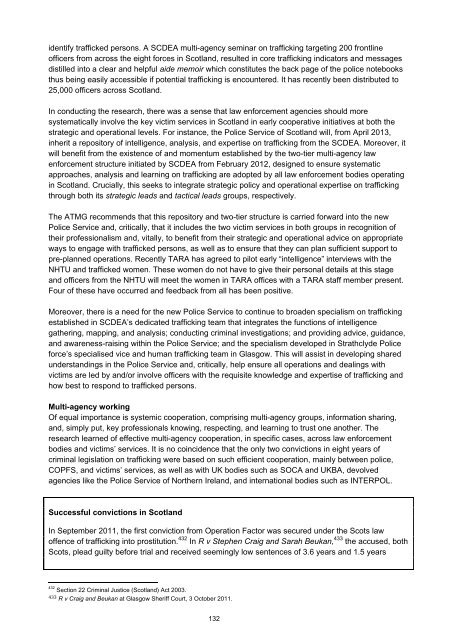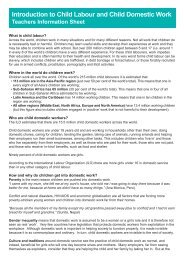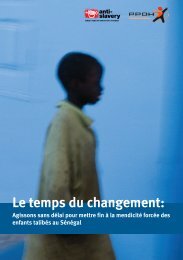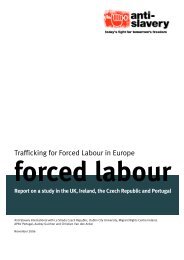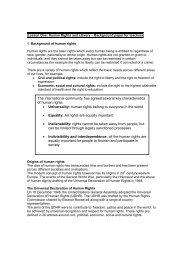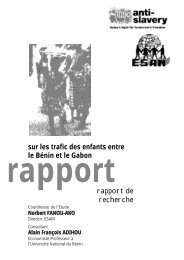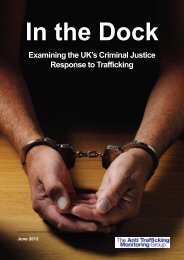identify trafficked persons. A SCDEA multi-agency seminar on trafficking targeting 200 frontlineofficers from across <strong>the</strong> eight forces in Scotland, resulted in core trafficking indicators and messagesdistilled into a clear and helpful aide memoir which constitutes <strong>the</strong> back page of <strong>the</strong> police notebooksthus being easily accessible if potential trafficking is encountered. It has recently been distributed to25,000 officers across Scotland.<strong>In</strong> conducting <strong>the</strong> research, <strong>the</strong>re was a sense that law enforcement agencies should moresystematically involve <strong>the</strong> key victim services in Scotland in early cooperative initiatives at both <strong>the</strong>strategic and operational levels. For instance, <strong>the</strong> Police Service of Scotland will, from April 2013,inherit a repository of intelligence, analysis, and expertise on trafficking from <strong>the</strong> SCDEA. Moreover, itwill benefit from <strong>the</strong> existence of and momentum established by <strong>the</strong> two-tier multi-agency lawenforcement structure initiated by SCDEA from February 2012, designed to ensure systematicapproaches, analysis and learning on trafficking are adopted by all law enforcement bodies operatingin Scotland. Crucially, this seeks to integrate strategic policy and operational expertise on traffickingthrough both its strategic leads and tactical leads groups, respectively.The ATMG recommends that this repository and two-tier structure is carried forward into <strong>the</strong> newPolice Service and, critically, that it includes <strong>the</strong> two victim services in both groups in recognition of<strong>the</strong>ir professionalism and, vitally, to benefit from <strong>the</strong>ir strategic and operational advice on appropriateways to engage with trafficked persons, as well as to ensure that <strong>the</strong>y can plan sufficient support topre-planned operations. Recently TARA has agreed to pilot early “intelligence” interviews with <strong>the</strong>NHTU and trafficked women. These women do not have to give <strong>the</strong>ir personal details at this stageand officers from <strong>the</strong> NHTU will meet <strong>the</strong> women in TARA offices with a TARA staff member present.Four of <strong>the</strong>se have occurred and feedback from all has been positive.Moreover, <strong>the</strong>re is a need for <strong>the</strong> new Police Service to continue to broaden specialism on traffickingestablished in SCDEA’s dedicated trafficking team that integrates <strong>the</strong> functions of intelligencega<strong>the</strong>ring, mapping, and analysis; conducting criminal investigations; and providing advice, guidance,and awareness-raising within <strong>the</strong> Police Service; and <strong>the</strong> specialism developed in Strathclyde Policeforce’s specialised vice and human trafficking team in Glasgow. This will assist in developing sharedunderstandings in <strong>the</strong> Police Service and, critically, help ensure all operations and dealings withvictims are led by and/or involve officers with <strong>the</strong> requisite knowledge and expertise of trafficking andhow best to respond to trafficked persons.Multi-agency workingOf equal importance is systemic cooperation, comprising multi-agency groups, information sharing,and, simply put, key professionals knowing, respecting, and learning to trust one ano<strong>the</strong>r. Theresearch learned of effective multi-agency cooperation, in specific cases, across law enforcementbodies and victims’ services. It is no coincidence that <strong>the</strong> only two convictions in eight years ofcriminal legislation on trafficking were based on such efficient cooperation, mainly between police,COPFS, and victims’ services, as well as with UK bodies such as SOCA and UKBA, devolvedagencies like <strong>the</strong> Police Service of Nor<strong>the</strong>rn Ireland, and international bodies such as INTERPOL.Successful convictions in Scotland<strong>In</strong> September 2011, <strong>the</strong> first conviction from Operation Factor was secured under <strong>the</strong> Scots lawoffence of trafficking into prostitution. 432 <strong>In</strong> R v Stephen Craig and Sarah Beukan, 433 <strong>the</strong> accused, bothScots, plead guilty before trial and received seemingly low sentences of 3.6 years and 1.5 years432Section 22 Criminal Justice (Scotland) Act 2003.433 R v Craig and Beukan at Glasgow Sheriff Court, 3 October 2011.132
espectively. <strong>In</strong> addition to custodial sentences, a confiscation order was granted for £45,000 to bepaid within six months against Craig. 434 However, <strong>the</strong>re was no mention of compensation for <strong>the</strong>victims ei<strong>the</strong>r by way of a compensation order or through CICA.The second convictions were in December 2012 under <strong>the</strong> UK offence of trafficking into exploitationfor <strong>the</strong> purpose of sham marriages. 435 This case involved three Slovakians who denied <strong>the</strong> chargesbut were found guilty and each received a three-year custodial sentence. Recently in HMA v Kupkaand O<strong>the</strong>rs concerning trafficking for benefit fraud, 436 three defendants were found guilty of fraud andassault. Kupka received four years’ imprisonment, Rondos three years and three months’imprisonment, and Fojtik two years and three months’ imprisonment. These sentences again are lowand <strong>the</strong>refore it can be argued that none of <strong>the</strong>se sentences are likely to dissuade profit-hungry andhardened traffickers from committing such crimes. It should also be noted that <strong>the</strong>re have been morethan 20 successful prosecutions of suspected traffickers for o<strong>the</strong>r criminal offences such as living offimmoral earnings, keeping bro<strong>the</strong>ls, and deception.Prosecuting traffickingThe research did not benefit from evidence from <strong>the</strong> COPFS as <strong>the</strong>y disappointingly decided afterinitial acceptance not to participate in this research. However, it is known that <strong>the</strong> COPFS are active inScotland and are putting significant effort into prosecuting trafficking as demonstrated by its role in <strong>the</strong>above convictions that included work by its Victim <strong>In</strong>formation and Advice Service. Fur<strong>the</strong>rmore, <strong>the</strong>COPFS produced a helpful victim leaflet which explains <strong>the</strong> criminal justice process.<strong>In</strong> terms of structure and guidance, it was reported that <strong>the</strong> COPFS appointed an advocate depute in<strong>the</strong> Sexual Crimes Unit as <strong>the</strong> Scottish lead for trafficking. The COPFS has also published 2010guidance on trafficking offences to coincide with some prosecutors being specifically trained intrafficking by o<strong>the</strong>r agencies within COPFS. Training for prosecutors who specialise in sexual offencesalso contained trafficking for sexual exploitation but not o<strong>the</strong>r forms. All of which is helpful, however,<strong>the</strong> guidance has not been updated since it was published in October 2010, despite <strong>the</strong> fact that <strong>the</strong>reis new relevant case law in England and Wales and <strong>the</strong> new Directive took full effect from April 2013.Fur<strong>the</strong>rmore, it could not be ascertained if updated training has been implemented and thosespecialist prosecutors are still employed by COPFS. It would appear that <strong>the</strong> low number ofprosecutions originates from a low number of cases investigated by <strong>the</strong> police or cases which involvepoor evidence ga<strong>the</strong>ring, which are passed to COPFS. This was a concern that was raised by <strong>the</strong>Lord Advocate in oral evidence to <strong>the</strong> Scottish Parliament Equal Opportunities Committee in 2010.However, if police activity on trafficking is to ga<strong>the</strong>r momentum in <strong>the</strong> future, prosecutors must have<strong>the</strong> most up-to-date skill set with knowledge of good practice accumulating in <strong>the</strong> rest of <strong>the</strong> UK, sothat when <strong>the</strong>se cases are eventually received <strong>the</strong>y are dealt with effectively.It is recommended that, to promote Scotland-wide proactive identification of traffickers and victims by<strong>the</strong>ir staff, <strong>the</strong> COPFS deepen and widen its specialism on trafficking through systematic awarenessraisingand updated customised training on all forms of trafficking, for key staff both centrally andacross its Federations. The COPFS should also update its public guidance to ensure it reflects allrelevant domestic legislation, key international legal instruments and case law.434BBC News, ‘Cash seized from convicted sex trafficker Stephen Craig’ 10 July 2012. Available at: http://www.bbc.co.uk/news/ukscotland-glasgow-west-18783948[last accessed 11 March 2011].435HMA v Kulova and o<strong>the</strong>rs, at Dundee Sheriff Court, 14 January 2013.436HMA v Kupka and o<strong>the</strong>rs, at Glasgow Sheriff Court, 20 March 2013.133
- Page 1 and 2:
In the DockExamining the UK’s Cri
- Page 3 and 4:
AcknowledgementsThis report was mad
- Page 5 and 6:
PrefaceIn May 2009, a group of nine
- Page 7 and 8:
Misconceptions around exploitation
- Page 9 and 10:
Acronyms and abbreviations frequent
- Page 11 and 12:
Executive SummaryIn the Dock is The
- Page 13 and 14:
Furthermore, the current legislatio
- Page 15 and 16:
The ATMG was made aware of some cas
- Page 17 and 18:
• Introduce mandatory child-speci
- Page 19 and 20:
• The UK’s ability to meet the
- Page 21 and 22:
Traffickers’ primary motivation i
- Page 23 and 24:
• Money launderers - turn profits
- Page 25 and 26:
out to perpetuate the exploitative
- Page 27 and 28:
[their] own enslavement” is as fu
- Page 29 and 30:
Chapter 2: UK Anti-Trafficking Legi
- Page 31 and 32:
nationals who commit trafficking of
- Page 33 and 34:
Like the SOA, the “act” element
- Page 35 and 36:
(b) D requires another person to pe
- Page 37 and 38:
Forced or compulsory labourThe defi
- Page 39 and 40:
ConclusionAs a consequence of the s
- Page 41 and 42:
concerningly, the number of convict
- Page 43 and 44:
women who were recruited in Poland
- Page 45 and 46:
Chapter 4: Identifying trafficking
- Page 47 and 48:
Misconceptions around exploitationT
- Page 49 and 50:
espond inadequately to a trafficked
- Page 51 and 52:
multi-agency teams was described by
- Page 53 and 54:
Josie Connors. 179 In summary, inte
- Page 55 and 56:
defending a trafficked person for f
- Page 57 and 58:
“[B]ecause the NRM decision is on
- Page 59 and 60:
PTSD. 196 A Consultant Psychiatrist
- Page 61 and 62:
etween the client and the police, i
- Page 63 and 64:
Regular communication needs to be s
- Page 65 and 66:
Priority planningA particular issue
- Page 67 and 68:
Chapter 6: Multi-agency and interna
- Page 69 and 70:
canvassing for tarmacking opportuni
- Page 71 and 72:
Despite this, it would appear that
- Page 73 and 74:
Good practice - Operation Golf 229O
- Page 75 and 76:
Chapter 7: Criminal proceedingsThe
- Page 77 and 78:
Law enforcement working on the case
- Page 79 and 80:
trafficking require particular unde
- Page 81 and 82:
JuryPractitioners suggested that th
- Page 83 and 84: years”. 258 Ambiguity within the
- Page 85 and 86: officer stated that not all judges
- Page 87 and 88: jurors to be assisted with expert e
- Page 89 and 90: Good feedback was received from sem
- Page 91 and 92: The Convention does recognise that
- Page 93 and 94: Another option for trafficked victi
- Page 95 and 96: There are two models with respect t
- Page 97 and 98: 1. Is there clear evidence that the
- Page 99 and 100: decision can be taken into account
- Page 101 and 102: also entails being “alert to the
- Page 103 and 104: In some cases concerns were even ra
- Page 105 and 106: Chapter 9: Prosecuting child traffi
- Page 107 and 108: However, many children are not refe
- Page 109 and 110: trafficking”. 352 It states: “W
- Page 111 and 112: Previous research has found that th
- Page 113 and 114: children as well as assisting in pr
- Page 115 and 116: Child trafficking trainingThere is
- Page 117 and 118: were too traumatic to involve them
- Page 119 and 120: committed by a child whilst in a co
- Page 121 and 122: • Introduce mandatory child-speci
- Page 123 and 124: IdentificationThe PSNI is the main
- Page 125 and 126: participants suggest that this is b
- Page 127 and 128: The PPS stated that the reasons for
- Page 129 and 130: this research was aware of potentia
- Page 131 and 132: convictions of traffickers prosecut
- Page 133: Possibly in response to certain hur
- Page 137 and 138: Conclusion and RecommendationsThe A
- Page 139 and 140: CRIMINAL PROCEEDINGS• Ensure that
- Page 141 and 142: Crown Prosecution Service, Legal Gu
- Page 143 and 144: Herman. J. Trauma and Recovery: The
- Page 145 and 146: Annex I: Trafficking and other form
- Page 147 and 148: (a) on summary conviction, to impri
- Page 149 and 150: (b) which country is the country of
- Page 151 and 152: 2009 Istvan Kalocsai (Snr)MetS.57 o
- Page 153 and 154: 2009 causing actual bodily harm, su
- Page 155 and 156: Skirmantas Kvedaras Feed, 2010 Rape
- Page 157 and 158: 2012 Ahdel Ali (24)Mubarek Ali (29)
- Page 159 and 160: Annex III: The CPS’s Seven Stages
- Page 161 and 162: 159


